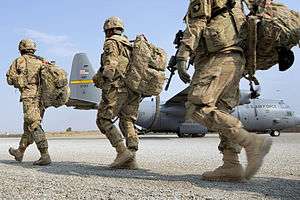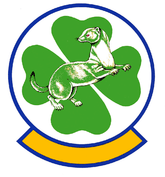774th Expeditionary Airlift Squadron
| 774th Expeditionary Airlift Squadron | |
|---|---|
 | |
| Active | 1943–1945; 1953–1971; 1972–1993; unknown |
| Country | United States |
| Branch |
|
| Role | Airlift |
| Part of | 455th Expeditionary Operations Group |
| Engagements |
|
| Decorations |
|
| Insignia | |
| 774th Expeditionary Airlift Sq emblem (approved 7 December 1973)[1] |
 |
| Patch with 774th Troop Carrier Squadron emblem (later version) |
 |
| 774th Troop Carrier Squadron emblem (approved 14 September 1953)[2] |
 |
| 774th Bombardment Squadron emblem |
 |
The 774th Expeditionary Airlift Squadron is a provisional United States Air Force unit, assigned to the 455th Expeditionary Operations Group at Bagram Air Base, Afghanistan. The squadron provides airlift to forces engaged in the War in Afghanistan.
During World War II, the 774th Bombardment Squadron was a B-17 Flying Fortress squadron, assigned to the 463d Bombardment Group of Fifteenth Air Force. It earned two Distinguished Unit Citations.
History
World War II

Established in mid-1943 as a Boeing B-17 Flying Fortress heavy bombardment squadron; assigned to Second Air Force for training. Attached in late 1943 and early 1944 to the Army Air Force School of Applied Tactics. Deployed to Mediterranean Theater of Operations in February 1944, squadron taking the South Atlantic Transport Route though the Caribbean and South America; transiting the Atlantic Ocean via Brazil and Dakar, French West Africa, being assigned to Fifteenth Air Force in March 1944 at several airfields in Southern Italy.
Engaged in long-range strategic bombardment of enemy military, industrial and transport targets, including oil refineries and production oilfields in Italy; France; Southern Germany; Austria and the Balkans. Continued strategic bombardment until German capitulation in May 1945. Demobilized in place in Italy during the summer of 1945; inactivated in September 1945.
Airlift operations

Reactivated as a Tactical Air Command Troop Carrier squadron in June 1953, assigned Fairchild C-119 Flying Boxcars. Engaged in transport of equipment and supplies; including support of Army Airborne parachute units throughout the 1950s and early 1960s. Equipped with new Lockheed C-130A Hercules in 1956, the squadron also operated a TAC-sponsored flight demonstration team during the late 1950s and early 1960s known as "The Four Horsemen," utilizing four C-130A aircraft.[3]
Deployed to Pacific Air Forces in 1966, being stationed in the Philippines. Engaged in airlift missions between the Philippines and South Vietnam, airlifting supplies and equipment to airfields in the combat areas; evacuating wounded personnel to hospitals at Clark Air Base. Remained in the Western Pacific until 1971 when inactivated as part of the drawdown of United States forces in the region.
Reactivated at Dyess Air Force Base, Texas as a theater airlift squadron in June 1972, initially under Tactical Air Command, later Military Airlift Command and lastly Air Mobility Command. Deployed frequently to Europe or the Pacific, performing intra-theater airlift missions with C-130s. Inactivated in October 1993 as part of the drawdown of the USAF after the end of the Cold War.
Redesignated 774th Expeditionary Airlift Squadron, converted to provisional status in 2001 and allotted to Air Combat Command to activate or inactivate as needed.[1]
Lineage
- Constituted as the 774th Bombardment Squadron (Heavy) on 19 May 1943
- Activated on 1 August 1943
- Redesignated 774th Bombardment Squadron, Heavy c. 29 September 1944
- Inactivated on 25 September 1945
- Redesignated 774th Troop Carrier Squadron, Medium on 1 December 1952
- Activated on 16 January 1953
- Redesignated: 774th Troop Carrier Squadron, Assault on 18 December 1961
- Redesignated: 774th Troop Carrier Squadron, Medium on 15 May 1965
- Redesignated: 774th Troop Carrier Squadron on 1 January 1967
- Redesignated: 774th Tactical Airlift Squadron on 1 August 1967
- Inactivated on 15 June 1971
- Activated on 1 June 1972
- Redesignated 774th Airlift Squadron on 1 November 1991
- Inactivated on 1 October 1993
- Redesignated 774th Expeditionary Airlift Squadron and converted to provisional status, on 4 December 2001
- Activated on 20 April 2002
- Inactivated on 18 March 2003
- Activated on 4 October 2004[1]
Assignments
- 463d Bombardment Group, 1 August 1943 – 25 September 1945
- 463d Troop Carrier Group, 16 January 1953
- 463d Troop Carrier Wing, 25 September 1957
- 840th Air Division, 23 November 1965
- 463d Troop Carrier Wing (later 463d Tactical Airlift Wing), 7 February 1966 – 15 June 1971
- 463d Tactical Airlift Wing, 1 June 1972 (attached to: 513th Tactical Airlift Wing, 5 September – 15 November 1974, 322d Tactical Airlift Wing, 12 October – 15 December 1973)
- 463d Operations Group, 1 November 1991 – 1 October 1993
- Air Combat Command to activate or inactivate at any time after 4 December 2001
- 320th Expeditionary Operations Group, 20 April 2002 – 18 March 2003
- 376th Expeditionary Operations Group, 4 October 2004
- 455th Expeditionary Operations Group, 6 January 2006 – unknown[1]
Stations
|
|
Aircraft
- Boeing B-17 Flying Fortress, 1943–1945
- Fairchild C-119 Flying Boxcar, 1953–1957
- Lockheed C-130 Hercules, 1956–1962; 1963–1971; 1972–1993[1]
See also
References
Notes
- ↑ Aircraft is Lockheed C-130H Hercules serial 93-7313e at Forward Operating Base Salerno, Khost Province, Afghanistan. Taken on 23 September 2013. At the time the 774th Expeditionary Airlift Squadron consisted mostly of deployed members of the Wyoming Air National Guard's 187th Airlift Squadron.
- ↑ Aircraft is B-17G serial 42-31684 "Joker". The plane flew with the 774th Bombardment Squadron from 9 May 1944 until it was downed by an enemy fighter over Blechhammer, while attacking the chemical plants there on 7 July.
- ↑ Aircraft is Lockheed C-130A-LM Hercules serial 55-31 taken in 1957.
Citations
- 1 2 3 4 5 6 Haulman, Daniel L. (May 18, 2018). "Factsheet 774 Expeditionary Airlift Squadron (ACC)". Air Force Historical Research Agency. Retrieved August 28, 2018.
- ↑ Maurer, Combat Squadrons, pp. 748-749
- ↑ "Lockheed C-130: The Four Horsemen Demonstrated the Power of the New Aircraft". HistoryNet. June 12, 2006. Retrieved 19 October 2016.
Bibliography
![]()
- Maurer, Maurer, ed. (1983) [1961]. Air Force Combat Units of World War II (PDF) (reprint ed.). Washington, DC: Office of Air Force History. ISBN 0-912799-02-1. LCCN 61060979. Retrieved December 17, 2016.
- Maurer, Maurer, ed. (1982) [1969]. Combat Squadrons of the Air Force, World War II (PDF) (reprint ed.). Washington, DC: Office of Air Force History. ISBN 0-405-12194-6. LCCN 70605402. OCLC 72556. Retrieved December 17, 2016.
Ravenstein, Charles A. (1984). Air Force Combat Wings, Lineage & Honors Histories 1947-1977 (PDF). Washington, DC: Office of Air Force History. ISBN 0-912799-12-9. Retrieved December 17, 2016.
External links
- 455th Expeditionary Operations Group Factsheet
- "C-130 Dyess timeline". Abeline Reporter News. April 23, 2011. Archived from the original on August 12, 2011. Retrieved January 29, 2014.
- "Hercules and the Four Horsemen". Lockheed Martin. 1960. Retrieved October 19, 2016. (YouTube video of Four Horsemen demonstration team)